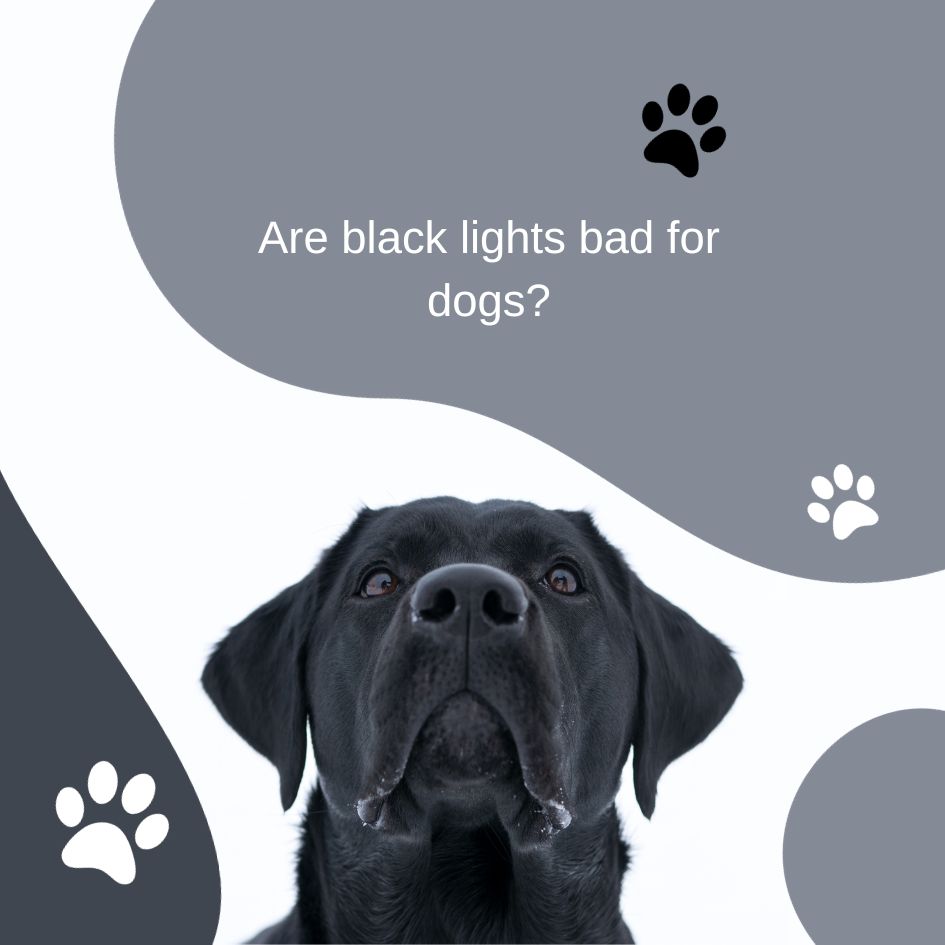Black lights are not inherently bad for dogs, but exposure to ultraviolet (UV) light can cause eye and skin damage. Dogs have more sensitive eyes than humans, so direct or prolonged exposure to black lights can be harmful.
- The Basics Of Black Lights For Dogs
- Understanding The Effects Of Black Lights On Dogs
- Potential Risks And Concerns With Black Lights For Dogs
- Factors To Consider When Using Black Lights On Dogs
- Alternatives To Black Lights For Dog-Related Purposes
- Myth Or Fact: Unraveling Common Misconceptions About Black Lights And Dogs
- Supporting Research And Expert Opinions On The Topic
- Frequently Asked Questions On Are Black Lights Bad For Dogs
- Conclusion
Additionally, some materials used in black light bulbs can emit harmful chemicals when heated, which may pose health risks to dogs. It is important to keep dogs away from black lights or use protective measures, such as using filters or ensuring proper distance, to minimize the risks associated with UV light exposure.
Understanding the potential dangers and taking precautions will help ensure the well-being of our furry friends.
The Basics Of Black Lights For Dogs
Black lights are not bad for dogs when used correctly. They can help identify stains and urine, making cleaning and maintaining a hygienic environment for your furry friend easier. However, excessive exposure to ultraviolet light can be harmful, so moderation is key.
Black lights are a fascinating piece of technology that can have different applications, including for dogs. But are black lights bad for our furry friends? This section will explore the basics of black lights for dogs to understand their purpose and how they work on their fur.
Why Are Black Lights Used For Dogs?
- Detecting urine stains: Black lights are commonly used to detect urine stains on various surfaces. This can be particularly helpful when house training a dog or identifying areas that need cleaning.
- Identifying skin conditions: Black lights can reveal certain skin conditions on dogs that are otherwise invisible to the naked eye. This can assist in diagnosing problems such as infection, ringworm, or mange.
- Scorpion hunts: Although not directly related to dogs, some adventurous pet owners use black lights to assist in locating scorpions during outdoor activities. This can help ensure a safer environment for their pets.
How Do Black Lights Work On Dogs’ Fur?
- Ultraviolet (UV) light: Black lights emit ultraviolet light, which falls outside of the range of visible light for humans but can be seen by certain animals, including dogs. There are two types of black lights: long-wave ultraviolet (UV-A) light and short-wave ultraviolet (UV-C) light.
- Fluorescence: Certain substances can emit visible light in response when exposed to UV light. This is called fluorescence. Some materials present on dogs’ fur, such as urine or certain bacteria, can fluoresce under black light, making them more visible.
- Reflective properties: Black lights can also reveal certain characteristics of dogs’ fur based on their reflective properties. This can help identify any abnormalities or changes in colour or texture that may be indicative of an underlying issue.
Black lights can serve as useful tools for dog owners and veterinarians. They are commonly used to detect urine stains, identify skin conditions, and even assist in scorpion hunts. Understanding how black lights work on dogs’ fur can help us utilize this technology effectively and keep our furry friends healthy and safe.
Understanding The Effects Of Black Lights On Dogs
Black lights can affect dogs differently, and pet owners need to understand them. While some dogs may be completely unfazed, others may experience anxiety or discomfort. It’s best to monitor your dog’s behaviour and consult with a veterinarian if necessary.
Black lights can be an intriguing and mysterious addition to any setting. These ultraviolet lights have various applications, from creating visually stunning glow-in-the-dark effects to identifying hidden stains. But what about our furry friends? Are black lights safe for dogs?
In this section, we will delve into the effects of black lights on dogs, particularly focusing on whether exposure to these lights can harm them or have adverse effects on their eyes.
Does Exposure To Black Lights Harm Dogs?
Exposing dogs to black lights can have potential effects on their well-being. Understanding the impact of UV light exposure is crucial, as it enables us to take appropriate precautions and ensure the safety and health of our canine companions. Here are several key points to consider:
- Increased sensitivity: Dogs tend to have a higher sensitivity to ultraviolet light compared to humans. While we may not experience any discomfort, dogs may be more susceptible to the effects of UV radiation emitted by black lights.
- Eye damage: Dogs’ eyes can be susceptible to damage from prolonged exposure to certain types of ultraviolet light. However, the risk depends on various factors, such as the intensity and duration of exposure and the individual dog’s overall eye health. It’s essential to be cautious and take preventive measures.
- Skin conditions: Black lights can help identify hidden stains on surfaces, including urine and bodily fluids. While this might be helpful for cleaning purposes, it’s important to note that excessive exposure to UV light can potentially aggravate certain existing skin conditions in dogs. Keep an eye out for any signs of discomfort or irritation.
- Prevention is key: To ensure the well-being of your furry friend’s well-being, limit their exposure to black lights whenever possible. This can be achieved by not subjecting them to UV light unnecessarily and minimizing their time under such lighting conditions.
Remember, consulting a veterinarian is always a wise decision when it comes to your dog’s health and well-being. They can provide personalized advice based on your pet’s specific needs and circumstances.
By understanding the effects of black lights on dogs, we can make informed choices to protect our four-legged companions. We can ensure their safety and prevent any potential harm to their eyes or overall health with proper precautions. So, let’s enjoy the fascinating glow of black lights responsibly while prioritizing the well-being of our furry family members.
Potential Risks And Concerns With Black Lights For Dogs
Black lights for dogs come with potential risks and concerns. While these lights can be helpful for detecting certain substances, prolonged exposure might harm a dog’s eyes and disrupt their sleep patterns. Using black lights for dogs with caution is crucial and consult a veterinarian if needed.
Are Black Lights Bad For Dogs
Black lights, also known as ultraviolet (UV) lights, have gained popularity for their vibrant glow and ability to make certain materials fluoresce. While enjoyable for humans, the same cannot always be said for our furry friends. In this blog post, we will explore the potential risks and concerns associated with black lights for dogs.
Can Black Lights Cause Skin Irritations In Dogs?
- Dogs have sensitive skin, and exposure to black lights can sometimes lead to skin irritations.
- Here are some common skin issues that may arise:
- Redness and inflammation: Prolonged exposure to UV light may cause skin to become red and inflamed.
- Dryness and flakiness: Black lights can dry out a dog’s skin, leading to dry patches and flaking.
- Itching and scratching: Dogs may experience increased itching and scratching due to the irritation caused by black lights.
- Allergic reactions: Some dogs may have allergies to black light, resulting in a range of symptoms like hives or rashes.
Can Prolonged Exposure To Black Lights Cause Health Problems For Dogs?
- Yes, prolonged exposure to black lights can pose health problems for dogs.
- Here are some potential health concerns:
- Eye damage: Just like humans, dogs’ eyes are sensitive to UV radiation. Long-term exposure to black lights can cause damage to their eyes, leading to conditions such as cataracts or corneal inflammation.
- Increased risk of cancer: Studies have shown that excessive UV exposure can increase the risk of skin cancer in dogs, especially those with lighter coats or less hair.
- Disruption of sleep patterns: Black lights emit blue light, which can interfere with dogs’ natural sleep cycles, causing restlessness and insomnia.
Dog owners need to be aware of these risks and take necessary precautions when using black lights around their pets. Monitoring exposure time and ensuring that dogs have a safe distance from the light source can help mitigate potential harm.
Remember, keeping our furry friends happy and healthy is always a top priority. So, next time you decide to bring out the black lights, be sure to consider the potential risks they may pose to your canine companion.
Factors To Consider When Using Black Lights On Dogs
Factors to consider when using black lights on dogs include the intensity of the light, the duration of exposure, and the dog’s response to it. While black lights can be useful for identifying certain issues like urine stains, it’s important to use them responsibly and ensure they don’t cause any harm to your furry friend.
Using black lights on dogs can be both fun and practical. However, as a responsible pet owner, it’s important to consider a few factors to ensure the safety and well-being of your furry friend. Before you grab that black light, here are some essential points to keep in mind:
How To Safely Use Black Lights On Dogs?
- Choose the right type of black light: Opt for a quality, pet-friendly black light that emits a safe level of ultraviolet (UV) light. Look for black lights designed for pet use to avoid harmful effects.
- Keep the distance: Maintain a safe distance between the black light and your dog. This will help prevent any discomfort or potential harm caused by prolonged exposure to UV light.
- Use the black light in well-ventilated areas: Ensure that the space you’re using the black light in has proper ventilation. This will help reduce any potential build-up of fumes or irritants that can negatively affect your dog’s health.
- Avoid shining the light directly into your dog’s eyes: Just like humans, dogs’ eyes are sensitive to bright light. Be cautious to avoid shining the black light directly into your dog’s eyes to prevent any discomfort or potential damage.
- Monitor your dog’s behaviour and reactions: Observe how your dog responds to the black light. If you notice any signs of stress, anxiety, or discomfort, it’s essential to discontinue use immediately. Your dog’s well-being should always be a top priority.
Are There Any Precautions To Take Before Using Black Lights On Dogs?
Prior to using black lights on your dog, it’s crucial to take certain precautions to ensure their safety and avoid any adverse effects. Here are some important precautions to consider:
- Consult with your veterinarian: Before introducing black lights into your dog’s routine, it’s wise to consult with your veterinarian. They can provide guidance specific to your dog’s breed, size, and overall health.
- Check for any pre-existing conditions: Certain medical conditions or sensitivities may make the use of black lights unsuitable for your dog. Make sure to check for any pre-existing conditions that could pose a risk before using the black light.
- Test the black light on a small area: Before exposing your dog to the black light, it’s prudent to test it on a small area first. This will help determine if your dog has any adverse reactions or sensitivities to the UV light emitted.
- Avoid overwhelming your dog: Some dogs may find the presence of the black light confusing or overwhelming. Introduce the black light gradually, allowing your dog to acclimate to its presence and avoid causing unnecessary stress.
By considering these factors and taking the necessary precautions, you can safely and responsibly enjoy using black lights on your dog. Remember always to prioritize your dog’s well-being and consult with your veterinarian if you have any concerns.
Alternatives To Black Lights For Dog-Related Purposes
Looking for alternatives to black lights for dog-related purposes? Discover safer options and learn if black lights pose any health risks to your furry friend. Keep your pup safe and explore other effective tools for dog-related needs.
Have you ever wondered if black lights are safe for your furry friend? While black lights can be useful for some dog-related purposes, there are alternatives worth considering. In this section, we will explore some safer options for black lights and discuss the pros and cons of using black lights versus these alternatives.
Are There Any Safer Alternatives To Black Lights For Dog-Related Purposes?
- Natural sunlight: Harness the power of the sun by using natural daylight to inspect and identify potential stains or messes left by your dog.
- LED flashlights: These compact and portable flashlights emit a bright light that can help you spot stains or behaviour signs without the potential hazards associated with black lights.
- UV light inspection kits: Designed specifically for pet owners, these kits come with a UV flashlight and accompanying glasses to help you locate messes and stains that may be invisible to the naked eye.
What Are The Pros And Cons Of Using Black Lights Versus Alternatives?
Black lights, while popular, are not the only option for dog-related purposes. Here are the advantages and disadvantages of using black lights compared to the alternatives mentioned above:
Black Lights:
- Pros:
- Easily detect urine stains and other biological matter that fluoresce under UV light.
- It can be effective in identifying potential health issues or problem areas.
- It can help you pinpoint hidden scorpion stains.
- Cons:
- Black lights may not work well in brightly lit environments, which can limit their effectiveness.
- It may create a potential health risk for both pets and humans due to exposure to UV radiation.
- It can give false-positive results, as certain substances other than biological matter may also fluoresce.
Alternative Options:
- Pros:
- Safe and reliable alternatives for dog-related purposes.
- Can be used in any lighting condition, making them more versatile than black lights.
- Some alternatives, like natural sunlight, are readily available and cost-effective.
- Cons:
- It may not fluoresce as strongly or accurately as black lights for identifying biological stains.
- Depending on the alternative chosen, additional tools or kits may be required.
- Alternatives may be less commonly known or available compared to black lights.
Ultimately, the choice between black lights and safer alternatives depends on your preferences, specific needs, and the context in which you will be using them. Consider the pros and cons of each option to make an informed decision that ensures the safety and well-being of both you and your four-legged companion.
Myth Or Fact: Unraveling Common Misconceptions About Black Lights And Dogs
Unravelling the Myth: Are black lights bad for dogs? Discover the truth behind common misconceptions, debunked with scientific evidence. Learn how black lights can be used safely and effectively for various purposes with your furry friend.
Examining Popular Beliefs And Myths Surrounding Black Lights And Dogs:
- Black lights are harmful to dogs
- Dogs have a greater sensitivity to black lights
- Black lights can cause eye damage in dogs
Sorting Fact From Fiction: What Is The Truth About Black Lights And Dogs?
Black lights have been a subject of much speculation when it comes to their impact on dogs. Let’s take a closer look at some common misconceptions surrounding black lights and dogs and uncover the truth behind them:
- Dogs’ sensitivity to black lights: It is commonly believed that dogs are more sensitive to the effects of black lights compared to humans. However, this is a myth. Dogs do have better night vision than humans due to their higher number of rod cells in the retina. But, their sensitivity to black lights is similar to that of humans. Black lights emit ultraviolet (UV) light; like humans, dogs can perceive this to some extent, but it doesn’t cause any harm or discomfort.
- Eye damage caused by black lights: Another common belief is that black lights can cause eye damage in dogs. This is purely a myth. Both dogs and humans have natural defence mechanisms against harmful UV rays. The outer layers of the eye, such as the cornea and lens, help filter out most of the UV radiation, preventing any potential harm. However, it’s essential to note that prolonged or excessive exposure to UV light can still harm dogs and humans, whether from natural sunlight or artificial sources such as black light.
- Black lights being harmful to dogs: Black lights themselves are not harmful to dogs. They emit UV light that can make certain materials or substances fluoresce, revealing hidden stains or contaminants. While prolonged exposure to UV light without proper protection can be harmful, it’s crucial to remember that responsible use of black lights poses no direct risk to dogs.
The common myths surrounding black lights and dogs are precisely that: myths. With proper use and responsible precautions, black lights can be useful for dog owners without harming their furry friends. It’s always advisable to consult a veterinarian before exposing your dog to new environmental factors, including black lights.
Supporting Research And Expert Opinions On The Topic
Black lights can have potentially negative effects on dogs, according to experts and research findings. Some studies suggest that prolonged exposure to black lights can harm a dog’s eyes and skin, leading to discomfort and health issues. Pet owners need to be aware of these risks and take necessary precautions to ensure their dog’s well-being.
Insights From Veterinarians And Pet Experts On Black Lights And Dogs:
Black lights are often used for various purposes, such as detecting urine stains, checking for counterfeit money, or creating a neon glow effect at parties. However, when it comes to using black lights around our furry friends, concerns may arise regarding potential harm.
To shed light on this topic, let’s take a closer look at what veterinarians and pet experts have to say about the effects of black lights on dogs.
– Research Studies And Findings Related To The Effects Of Black Lights On Dogs:
Research studies in this area are limited, but researchers have explored the potential impact of black lights on dogs. Here are some key findings:
- Ultraviolet (UV) light emitted by black lights is known to have harmful effects on living organisms, particularly when it comes to extended exposure. It can cause damage to the skin, eyes, and cells.
- Dogs’ eyes are more sensitive to UV light compared to humans. Prolonged exposure to UV light can lead to conditions like photokeratitis and cataracts in dogs.
- Some studies suggest that certain breeds with lighter-coloured furs, such as Dalmatians and Bull Terriers, may be more susceptible to UV-related eye problems.
- Black lights also have the potential to exacerbate pre-existing skin conditions, including allergies and dermatitis, due to the increased visibility of certain substances or irritants under the UV light.
While these findings give us a glimpse into the potential risks, it is important to note that more extensive research is needed to understand the effects of black lights on dogs fully.
While there is limited research on the topic, experts advise caution when exposing dogs to black lights, especially for extended periods. It is recommended to consult with a veterinarian if you have concerns about using black lights around your canine companions.
Their professional guidance can provide you with the best course of action to ensure the well-being and safety of your furry friends.
Frequently Asked Questions On Are Black Lights Bad For Dogs
Is UV Light Harmful To Dogs?
UV light can be harmful to dogs, just like it can be harmful to humans.
What Do Dogs See In Blacklight?
Dogs can see certain things under black light due to their ability to detect ultraviolet light.
Can Black Lights Be Harmful?
Black lights can be harmful if exposed to directly, as they emit ultraviolet (UV) radiation.
How Do Dogs React To UV light?
Dogs can react to UV light, but it is not a significant concern for their eyes.
Conclusion
Black lights can be a source of curiosity and entertainment, but it’s important to consider their safety when it comes to our furry friends. While black lights are not inherently bad for dogs, there are a few precautions to remember.
Ensuring that the black light you choose emits a safe level of UV radiation is crucial, as excessive exposure can harm your dog’s eyes and skin. Additionally, it’s important to keep the black light out of your dog’s reach to prevent accidental ingestion or injury.
If you notice any adverse reactions in your dog, such as excessive blinking, redness, or skin irritation. Overall, by taking these precautions and using black lights responsibly, you can still enjoy the fun and excitement they bring to your home while keeping your furry friend safe and sound.




